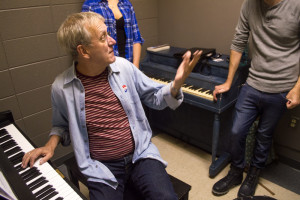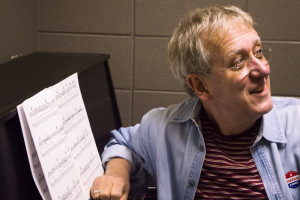Tags
Related Posts
Share This
The Laramie Project
A thread weaves between the productions in the Performing Arts Department: social consciousness, an anchor between acting and reality. Girls Like That dealt with girl-on-girl bullying and character assassination. The Stanford Rape Case: The Letter In Full was a poignant outcry of a victim of sexual assault. It is suitable that the next performances will deliver an equal amount of thoughtfully shaped awareness. The Laramie Project by Moisés Kaufman and the sequel The Laramie Project: Ten Years Later both circle the 1998 murder of Matthew Shepard, a gay student at University of Wyoming. As a reaction piece, the shows are well-rounded expressions of society’s reception of a hate crime.
William Wesbrooks, New Mexico native and seasoned director, works on the subject matter of The Laramie Project and Ten Years Later. Wesbrooks has been directing professionally for 20 years and began teaching at New York University in 2001, still roaming from New York to New Mexico when possible.

With a clear vision of how to make these productions successful, Director William Wesbrooks spends time with students perfecting a musical piece featured in the performances. Photo by Jennifer Rapinchuk
“I decided that Santa Fe was where I ultimately wanted to be,” Wesbrooks says. When he was offered the opportunity to come to SFUAD by PAD Chairwoman Laura Hawkes in light of his retirement from NYU, he gladly accepted, taking on the less rigid challenge of directing a Rehearsal and Production show, which are designed to deliver an immersive rehearsal and production process for those who were not cast in main stage shows.
“Bill is an incredible program director and educator,” Hawkes says. “His work in performance at NYU Steinhardt is high-profile and has been very successful. When it was clear he was making a longer term transition to full-time life in Santa Fe, we spent time talking about possible upcoming opportunities at SFUAD, musing over meaningful projects where he could work with our students.”
Wesbrooks is as talented as he is passionate about his artistic missions, and the opportunity to do something slightly unconventional with a mixed group of students.
“While I was always interested in The Laramie Project, I also needed something that would be adaptable,” Wesbrooks says. “I didn’t know how many students I would have, how many boys, or how many girls. I’m able to serve the students by making sure they have roles to play.”
Wesbrooks discovered Ten Years Later when he started work on The Laramie Project, which was a convenient solution to his large cast seeing as he could then split them between the shows. It seems like twice the work, but Wesbrooks prefers to see the two as one cohesive body of work covering a long span of time—the biggest difference between them being the approach to the tragedy.
“The Laramie Project is much more complex,” Wesbrooks says. “It was done in the year immediately following Matthew’s murder, so there’s a sense of immediacy. In the second play, you find out what has and has not happened and how people have tried to retell the story. So the second play is interesting in terms of its content, but not as compelling as a theater production. Not as strongly structured.”
In regards to the question of how these two productions tie in with the subject matter that has been active in other director’s play choices, Wesbrooks states that while it is ultimately about the director’s taste, it is also about the influence of the current state of the world.
“I think any kind of event like this is compelling. Stories when people are abused, killed, attacked for some reason of bias are important stories in and of themselves,” Wesbrooks says. “We are now in a political time where we are seeing how people can look at the fears, biases and concerns of a group of people and activate them.”
In The Laramie Project and Ten Years Later, those facets of people in light of a hate crime are revealed for better or for worse, ranging from bigoted anger to appropriate grief. The diversity of the message, or having no real message whatsoever beyond what bystanders felt happened, sets these productions apart. Wesbrooks hopes that the audience will stand by the play, even when it is hard to watch.

William Wesbrooks, director of SFUAD’s productions of The Laramie Project and The Laramie Project: Ten Years Later, works with students on a musical piece for the plays. Photo by Jennifer Rapinchuk
“It’s what it reveals about the community. People even say they thought he deserved to die. It’s important to know there are people who thought that and in our society there are still people who think that,” Wesbrooks says. “Sometimes, in university settings and in Santa Fe, it’s important for us to be reminded that this isn’t the way the rest of the world functions.”
Ultimately, his hopes are that students and audiences can connect with the difficulty of the story and absorb all sides of Shepard’s death beyond the fact that it was done with malevolence. He believes tragedy in theater is different as it happens in front of viewers, placing them in the same moment the actors are living in.
“There’s an energy between the story and the audience, so I always hope for a sense of immediacy, that the story feels alive. Yes, we know that this happened almost 20 years ago,” Wesbrooks says. “But there’s a sense that you’re right there in the room with someone’s consciousness, bigotry and love.”
The Laramie Project opens at 7 p.m. on Wednesday, Oct. 19, followed by The Laramie Project: Ten Years Later at 7 p.m. on Thursday, Oct. 20. Both performances will be located in The Forum.






 Jackalope Magazine is the student magazine of Santa Fe University of Art and Design. Building on the interdisciplinary nature of our education, we aim to showcase the talent of our university and character of our city.
Jackalope Magazine is the student magazine of Santa Fe University of Art and Design. Building on the interdisciplinary nature of our education, we aim to showcase the talent of our university and character of our city.
Recent Comments